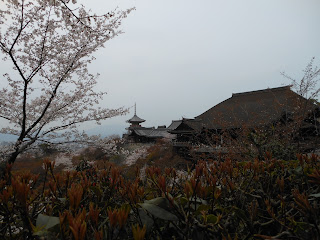Hello family and friends,
When Matt and I arrived in Nagoya in late February, it was just when the sake brewery season started. And sadly enough, we didn't know about the open houses nearby sake breweries had on for the public at the time. By the time I heard about it, all the breweries were closed to finish the bottling process.
BUT, by my ingenuity (if I may say so myself), I phoned up one of the oldest sake brewery in our area, and made a reservation for a tour ALL IN JAPANESE. That's right - even here, I'm a superstar. :)
So Matt and I were able to not only go on a sake tour, but we got a
private sake tour by the owner.
How AWESOME am I?!
(I'm pretty awesome)
Anyway, here is our sake brewery tour.
It was Saturday March 16, 2013 on an overcast, chilly day, when Matt and I traveled to the Odaka region by train. Odaka is a little village/town about 20min south of Nagoya and is famous for sake brewery because of its water. We actually got a little lost trying to find the brewery, but alas we found it and the owner was quick to welcome us into his little parlour. He proceeded to hand us a process map of how sake brewery is done. Though all in Japanese, we were able to communicate with him using our much improved hand gesturing techniques and Google Translate.
After 10-15 minutes of conversation, he led us through his shop. He was so kind and asked one of his employees who spoke a little English to help guide and explain the different steps. So we were able to really learn from the master how sake brewery is done. We learned what kind of rice is used for certain types of sake, how the rice needs to be washed in a certain way, then steamed in an oven of sorts before applying Koji, a sort of mold that attacks the rice. Yeast is subsequently applied and fermented for anywhere between 2 - 4 weeks. The aroma is heavenly. Then pressing is done to separate the solid from the liquid. The press is huge and reminded me of a big stamping machine. The liquid is then filtered and pasteurized. As an option, some sake are then aged some more before bottling begins.
Next we were off to the sake tasting. Matt and I tried 2 different sake - one that was just bottled this year and another that was a year old. The 2013 sake was stronger in alcohol and had almost a sharp after taste at the end, whereas the aged sake was smooth tasting and very lovely.
Here is the selection they offered for sake tasting - we tried the left most green bottle (the 2013 sake) and the right most brown bottle (aged). We bought the brown bottle.
The sake brewery we went to was called Kaminoi. Kaminoi is a family owned sake brewery that's been around since 1856. They make 20 different kinds of sake every year. Last year at the centennial sake brewery competition held in Hiroshima, Kaminoi took home the gold prize for one of its sake.
The left is the gold prize certificate and the prize winning sake is the blue bottle (2nd from the right) on the right picture.
Here's us and our guide and owner, along with a bottle of sake we purchased there.
Thanks Kaminoi for a wonderful day!






























































